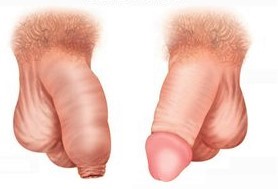Pre-operative (Preperations)
After the appointment for a treatment is confirmed, you will receive information about the circumcision by e-mail. It contains everything you need to know about the circumcision and the care after, so please read this information carefully.
We have briefly summarized below what you should do before you visit our clinic:
- Make sure you have shaved the pubic area and you have showered.
- Take paracetamol 1000mg one hour before the appointment.
- Wear half-tight underpants / boxer shorts or bring them with you.
- You may take your tablet or smartphone with you as a distraction.
- The circumcision is under local anesthesia, so you can basically do everything after the circumcision, but you are advised to take someone with you for support.
Perioperative (At the clinic)
When you arrive at the clinic we hand out administrative forms such as the declaration of the informed consent for the circumcision. After the payment is completed an intake interview follows.
During this interview we ask questions about your health and you receive information about the method and the care before, during and after the circumcision, including the possible complications (even though the chances are small). Please ask any questions and if everything is clear, the informed consent form must be signed.
The local anesthetic is given through small injections at the base of the penis. The penis will be completely numb after a few minutes. The circumcision will take place after the anesthesia is checked. This will approximately take 15 to 20 minutes.
The method
In adults, the classic method is used with sutures. This ensures that you see immediate results after the circumcision and that you no longer have to return for a follow-up. The classic method applied in our clinic is a minimally invasive method, ensuring that the safety is guaranteed and the blood loss kept to a minimum.

Post-operative (Aftercare)
For the healing of the wound, it is important to follow the aftercare instructions carefully. However, we understand that you cannot remember everything on such an exciting day. All follow-up instructions are included on paper. This allows you to read everything at home. If you still have questions you can always contact BesnijdenisPunt during office hours through the general number. In case of emergency, you can always reach us 24/7 through the emergency number. Generally, a follow-up does not take place. However, if you prefer to have a follow-up, you can make an appointment by calling or e-mailing us.
Complications
A circumcision is basically a safe and minor surgical procedure, however, as with any surgical procedure, complications can occur even though this is rare. In the informed consent form all complications are described and during the interview these are pointed out again.
Listed below are the possible (and also very rare) complications:
- A little blood loss (a few drops), which stops eventually, is normal.
- If the penis is fiery red, painful and swollen after a few days along with a fever, this may indicate an infection.
- Difficult urination and a burning sense.
- Swelling: The penis can often be swollen a few days after the circumcision due to the anesthetic fluid and surgery and may be accompanied by pain. This is normal and will pass eventually. Sometimes there is a lot of swelling of the thin inner skin through which the foreskin can stretch and therefore possibly a second intervention is required.
- There may sometimes be adhesions between the foreskin and the glans border. This can be solved mostly manually.
- Sometimes a difficult wound healing can occur because the wound edges will recede, which means it will take longer for the wound to close and heal.
- If there is a lot of fat on the pubic bone (pubic fat) and/or the penis is below the skin level, the glans may reach under skin level due to the formation of adhesions or phimosis (narrowing of the foreskin), which may require a second intervention later on.
- There are rare complications described in literature, such as the meatus stenosis and urethrocutaneous fistulae (urethra problems).

